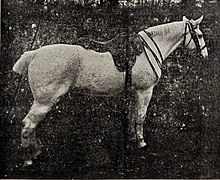
The Percheron is a breed of draft horse that originated in the Huisne river valley in western France, part of the former Perche province, from which the breed takes its name. Usually gray or black in color, Percherons are well-muscled, and known for their intelligence and willingness to work. Although their exact origins are unknown, the ancestors of the breed were present in the valley by the 17th century. They are believed to descend from war horses. Over time, they began to be used for pulling stagecoaches; and later, for agriculture and hauling heavy goods. In the late 18th and early 19th centuries, Arabian blood was added to the breed. Exports of Percherons from France rose exponentially in the late 19th century, and the first purely Percheron stud book was created in France in 1893.

The Selle Français (SF) is a breed of sport horse from France. An athletic horse with good gaits, it is usually bay or chestnut in color. The Selle Français was created in 1958 when several French riding horse breeds were merged into one stud book. The new breed was meant to serve as a unified sport horse during a period when horses were being replaced by mechanization and were transforming into an animal used mainly for sport and leisure.

The Trait Breton is a French breed of draught horse. It originated in Brittany, in north-west France, from cross-breeding of local horses with various other breeds. It is strong and muscular, and often has a chestnut coat.

The Poitevin or Poitou is a French breed of draft horse. It is named for its area of origin, the former province of Poitou in west-central France, now a part of the region of Nouvelle-Aquitaine. It was formed in the seventeenth century when horses of Flemish or Dutch origin, brought to the area by engineers working to drain the Marais Poitevin, interbred with local horses. Although it has the size and conformation of a draft horse, the Poitevin has never been bred for draft abilities, and has been little used for draft work. Its principal traditional use was the production of mules. Poitevin mares were put to jacks of the large Baudet du Poitou breed of donkey; the resulting Poitevin mules were in demand for agricultural and other work in many parts of the world, including Russia and the United States. In the early twentieth century there were some 50,000 brood mares producing between 18,000 and 20,000 mules per year.

The Anglo-Norman horse is a warmblood horse breed developed in Lower Normandy in northern France. A major center of horse breeding, the area had numerous regional types that were bred to one another and then crossed with Thoroughbreds to form the Anglo-Norman. Various body types developed within the Anglo-Norman breed, two of which were split off to form the Norman Cob and French Trotter. The remaining types were eventually standardized, although there remained some criticism of the "hybrid" nature of the breed's conformation. However, it is successful as an international sport horse, especially in the sport of show jumping. The Anglo-Norman also contributed to the development of several other breeds in Europe and Asia.

The Norman Cob or Cob Normand is a breed of light draught horse that originated in the region of Normandy in northern France. It is of medium size, with a range of heights and weights, due to selective breeding for a wide range of uses. Its conformation is similar to a robust Thoroughbred, and it more closely resembles a Thoroughbred cross than other French draught breeds. The breed is known for its lively, long-striding trot. Common colours include chestnut, bay and seal brown. There are three general subsets within the breed: horses used under saddle, those used in harness, and those destined for meat production. It is popular for recreational and competitive driving, representing France internationally in the latter, and is also used for several riding disciplines.

The Bidet was a type of small horse from France, now extinct. It was a landrace developed principally in the area around Brittany, Morvan, Auvergne, Poitou, and Burgundy. It stood about 110–135 centimetres at the withers. Two distinct groups are documented, which were bred in a semi-feral state.
The Cheval du Morvan, also known as the Morvandiau, Morvandain or Morvandelle, is an extinct French horse breed from the Morvan massif in Burgundy, for which it is named. Horses were bred in the Morvan from before the French Revolution, both as saddle-horses for fox-hunting and as cavalry mounts, and for draught use. They were of small to medium height and known for their strength and tenacity. The Cheval du Morvan became extinct with the advent of industrialisation and improved transportation in the nineteenth century. As a draught horse it was replaced by the Nivernais and Comtois breeds, and as a saddle-horse by the Thoroughbred.

The Cauchois, also known as the Norman bidet, is a breed of heavy draft horse native to the Pays de Caux, on the coast of the former Haute-Normandie region of France. Valued for its strength and ability to move at a high pace, the Cauchois was especially sought after during the 17th and 18th centuries. These horses were primarily used for hauling heavy loads, including the stagecoaches operated by the Compagnie Générale des Omnibus, but they were also ridden by local peasants to transport goods to market.

Fuschia was a trotter horse born in the Manche region of France, and head of the French Trotter breed. Winner of 17 of the 20 races in which he competed in mounted trotting from age 3 to age 5, he is best known for having been an excellent sire at the Le Pin national stud, to the point of imposing for the first time a lottery system for the allocation of breeding rights to brood mares.
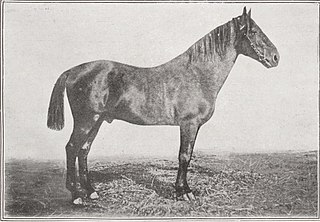
Niger was a trotter horse originated from a lineage of the now-extinct French Trotter breed. A son of The Norfolk Phœnomenon, he was a grandson or great-grandson of the English stallion The Norfolk Phenomenon. His dam, Miss Bell, was a half-blood mare of English or American origin, reputed to have served Napoleon III.

Narquois was a racehorse born in Calvados, an Anglo-Norman trotter. He was one of the first sons of the main stallion behind the French Trotter, the head of the Fuschia breed. Like him, Narquois became an excellent competitor, but at the same time was renowned for his ugliness. He usually competed in pairs with his half-sister, the mare Nitouche.

Phaéton was an Anglo-Norman trotting horse, son of the Thoroughbred The Heir of Linne, considered a founding stallion of the French Trotter breed. An average competitor, Phaéton, a cross between a Thoroughbred and a Norfolk Trotter, made his name thanks to the excellent performances of his offspring during his stallion career at the Haras National du Pin. Phaéton became one of the four great founders of the modern French Trotteur, along with the stallions Normand, Conquérant and Lavater.

Quorida de Treho is a chestnut mare, registered in the Selle Français genealogical register, daughter of Kannan and Dalais, by Tolbiac des Forêts. Born at Cruguel in Morbihan (Brittany), she was trained as a show jumper, successfully completing the classical show jumping cycle. Subsequently ridden by Franco-Swiss rider Romain Duguet, the pair reached the level of international competitions, winning the Saut Hermès jump, the CSIO in St. Gallen and the bronze medal at the European Show Jumping Championships in 2015, as well as the Helsinki World Cup stage twice, in 2015 and 2016. Quorida is voted Horse of the Year 2015 in Switzerland by the German-speaking readers of PferdeWoche.

The Breton bidet is a type of bidet, a small horse bred in Brittany. Characterized by its ability to move at amble, and bred for its working strength, the bidet has been around since the 5th century. In the Middle Ages, it may have been crossed with oriental horses brought by the House of Rohan. Widespread in Brittany until the mid-nineteenth century, bidets were used for all work requiring a low-value horse. The Haras Nationaux fought against this breeding. Transportation modernized in the 19th century, making the draft horse more sought-after. The Breton bidet disappeared at the dawn of the 20th century.

Conquérant was a founding stallion of the French Trotter horse breed, born in 1858 in Cotentin, Normandy, to breeder Pierre Étienne Joseph-Lafosse, and died in 1880. Son of the mare Élisa and the stallion Kapirat, descended through him from the almost Thoroughbred Young Rattler, he had an excellent racing career in mounted trotting for the Basly stable. Sold to the Haras Nationaux in 1862 after his racing career, Conquérant became a sought-after sire of 66 trotters.
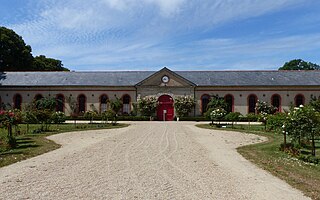
The Haras National d'Hennebont is one of five equestrian centers in the French region of Brittany. It was created in 1856 in Hennebont, Morbihan, around the former Abbey of La Joie, as a result of an exchange with the Abbey of Notre-Dame de Langonnet. Inaugurated by Napoleon III on August 15, 1858, it was classified as a historic monument in 1995.

The Corlay horsebreed is a type of half-blood horse resulting from crossbreeding around the town of Corlay in Brittany, between local Breton bidet mares and imported stallions, primarily Thoroughbreds. Intended for racing, this variety of Breton horse is reputed to have impressed Napoleon III with its steeplechase abilities. As a result, local breeders specialized in this racehorse, optimizing its feed by adding maerl to the diet. Corlay horse breeding gained an excellent reputation from the mid to late 19th century. The most influential stallion in the breed was named Corlay, who bred from 1876 to 1897 in the locality of the same name. The breed was considered established by the end of the century.
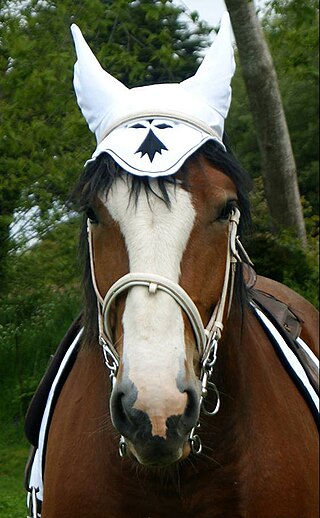
Horses in Brittany have a clear historical, economic and cultural importance, since their introduction often attributed to the Celts. In Brittany, the horse, generally a Breton bidet, was mainly used as a saddle animal until the middle of the 19th century. As roads improved, most breeders specialized in draft horses and carriage horses. They mainly settled in the west, in Basse-Bretagne, Trégor and Léon. The Breton draft horse, a renowned working animal, was exported in large numbers from Landivisiau in the early 20th century.
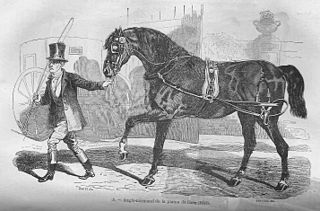
The Carrossier noir du Cotentin is a large, black, pulling horse breed unique to Cotentin. It was regularly described and quoted during the Ancien Régime and may have descended from Danish horses. As its name suggests, this horse was mainly used to pull carriages, and its uniform color made it possible to form homogeneous groups.



